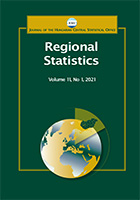A composite indicator to evaluate EU membership: The case of Central and Eastern European member states, 2004–2021
A composite indicator to evaluate EU membership: The case of Central and Eastern European member states, 2004–2021
Author(s): Viktória Endrődi-Kovács, Oleg TANKOVSKYSubject(s): Social Sciences, Economy, Geography, Regional studies
Published by: Központi Statisztikai Hivatal
Keywords: Central and Eastern European countries; new member states; composite indicator; EU accession
Summary/Abstract: The European Union (EU) experienced its largest expansion in 2004, when ten countries from Central and Eastern Europe (CEE) joined. This was followed by the accession of Bulgaria and Romania in 2007 and Croatia in 2013. The purpose of this study is to demonstrate how these countries have been able to benefit from EU membership. The topic’s relevance is emerging because of discussions with candidate countries for EU membership. Before a new round of accessions, it is important to assess how previously admitted states have been able to benefit from their membership and what lessons can be learned from their cases. The paper covers the period between 2004 and 2021. The main questions concern the evolution of select CEE countries in recent years, the results that have already been achieved, and the weakest features of their integration. The paper suggests that although these countries have been able to benefit from membership, they still face significant challenges as members of the EU. To endorse this suggestion, the paper applies Tibor Palánkai’s integration maturity and profile theories. The research builds on two hypotheses: first, the CEE countries in the analysis could improve their integration profile if they developed deeper economic ties with other EU members; second, countries that are located closer to the core countries of the EU (such as Austria and Germany) could exploit most of the benefits as a result of higher foreign direct investment (FDI) attractiveness. The paper designs a new composite indicator to provide a comprehensive understanding of the costs and benefits of EU membership. The findings support the hypotheses: countries such as the Czech Republic, Poland and Slovenia, which have formed deeper economic (trade and investment) relations with the EU’s core countries, could significantly improve their composite indicator values. The results can contribute to integration theory and enlargement decision-making.
Journal: Regional Statistics
- Issue Year: 13/2023
- Issue No: 05
- Page Range: 899-924
- Page Count: 26
- Language: English

